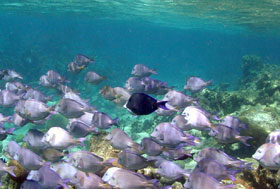You are here: Home › About Us › Accomplishments
Accomplishments

NCCOS' Center for Sponsored Coastal Ocean Research (CSCOR) has had numerous accomplishments to date. CSCOR has excelled at providing basic scientific research that is directly relevant to resource management needs, synthesizing research findings and developing forecasts for resource managers. CSCOR’s most significant accomplishments include:
Recent Accomplishments
For more CSCOR news, click here
Historical Accomplishments
Olympic Region Harmful Algal Bloom Program (ORHAB)
Along the coast of the Washington Olympic Peninsula, razor clam and Dungeness crab harvesting have been closed for long periods of time due to blooms of two neurotoxin producing HABs, Pseudo-nitzschia and Alexandrium.
The Olympic Region Harmful Algal Bloom (ORHAB) partnership, initially funded by NOAA in 2000, continues its ongoing partnership comprised of federal, state and local management agencies, coastal Indian tribes, marine resource-based businesses, public interest groups, and academic institutions that developed a state-of-the-art shellfish monitoring program along the Washington coast. ORHAB provides managers up to a week's early warning, allowing for timely and selective closures.
Coastal Change Analysis Program (C-CAP)
CSCOR developed a standard, nationally accepted protocol for mapping submerged aquatic
vegetation, emergent coastal wetlands, and adjacent uplands in the
Coastal Change Analysis Program (C-CAP). Using satellite imagery and
aerial photography to monitor areal extent, functional status and change
in these critical habitats, CSCOR performed regional land cover and
change detection studies were done in the Chesapeake Bay region as
well as Alaska, California, Florida, Georgia, Louisiana, Maine, Massachusetts,
New Jersey, New York, North Carolina, Texas, Oregon, Washington, and
Canada. C-CAP was transferred to NOAA Fisheries in Fiscal Year 1996
and is now operational in NOAA Ocean
Service's
Coastal Services Center.
CoastWatch Program
The
CoastWatch Program provides access to near real-time and retrospective satellite images and in
situ data and aircraft observations to decision-makers and researchers.
Available information includes sea surface temperature, ocean color,
and ocean surface winds, which can be used to prepare and issue
watches and advisories for environmental conditions such as red tide
and El Niño. CoastWatch was transferred to NOAA Satellites and
Information in Fiscal Year 1995 and is now operational nationwide.
Great Lakes Coastal Forecast
System
The
Great Lakes Forecasting System combines data from satellite,
land, and lake-based systems with computer models for real-time prediction
of the physical status of the Great Lakes. The system links existing
models, computer systems, and data networks to provide data assimilation,
modeling, data display, and distribution. The three-dimensional numerical
model predicts currents, temperatures, and water levels. Output from
the forecasting system includes maps and data sets tailored to display
specific information required by particular user groups. The Great
Lakes Forecasting System was transferred to NOAA’s
Great Lakes Environmental Research Laboratory and Ohio State University
and is now operational.
CSCOR also initiated a similar effort to develop a real-time atmosphere-ocean operational system for the U.S. East Coast. Four estuarine or port modeling and forecasting efforts are operational; the larger scale East Coast Forecast System continues to be developed by the NOAA Ocean Service - Office of Coast Survey.
Bering Sea Fisheries
Oceanography Coordinated Investigation (BS FOCI)
The
Bering Sea Fisheries Oceanography Coordinated Investigation (BS FOCI)
was a genetic assessment for stock identification. This study found
that Walleye pollock in the Bering Sea's Donut Hole region were not
a "self-sustaining" population
due to low food availability in that area. In addition, the pollock
in the Donut Hole are exclusively biologically part of U.S. stocks
that were being harvested by international fleets. The BSFOCI finding
that the donut hole population of pollock was not a self-sustaining
stock led directly to the international agreement that closed the
Donut Hole fishery.
Georges Bank Predation
Study (Multi-species Focus)
The Georges Bank project provided predation information on cod and
haddock to the New England Regional Management Council. This project
identified a shift in the prey-predator relationships on Georges Bank
in Maine and the effects of changes in currents on larval mortality.
As a result of these findings, the Council felt it was important to
include a multi-species management component in Amendment 7 of the
Magnuson-Stevens Fishery Conservation and Management Act, which sought
to reduce fishing pressure on Georges Bank. Without the information
from this project, there would have been no justification to move beyond
the traditional single-species approach.
Nutrient Enhanced Coastal Ocean Program (NECOP)
The
Nutrient Enhanced Coastal Ocean Program (NECOP) documented
the extent of nutrient input and hypoxia in the northern Gulf of Mexico,
developed the first mass-balance water quality model that predicts
water quality responses to various nutrient reduction strategies in
the Mississippi watershed, and helped initiate political-management
decisions through tools such as the 1995 Hypoxia Management Conference
designed to address the hypoxia problem.
CSCOR has published six technical reports and a final integrated report that form part of an assessment of hypoxia in the northern Gulf of Mexico. These reports support efforts of the White House Office of Science and Technology Policy - Committee on Environment and Natual Resource's scientific assessment of the causes and consequences of Gulf hypoxia through its Committee on Environment and Natural Resources (CENR).
Decision Analysis Series
Assessment, synthesis and
dissemination of existing coastal resource information is needed to ensure that decision makers have access to
appropriate, useful information for management decisions.
To return to CSCOR Home Page, click here

